Competitive Advantage
Outperforming your competitors
What Is a Competitive Advantage?
Competitive advantage is the ideal long-term objective of an organization in becoming more profitable than its competitors by providing customers with products and services that outrival competitors within the same market.

A competitive advantage contributes to a firm's long-term growth and value creation by optimizing resources and capabilities that produce distinctive core competencies and create value for the company and end consumers. It
is one of the main goals of a business strategy. It can help achieve more significant profits and marginal revenue and defend against competitive forces to survive.
Since competition can either make or break an organization, having a sustainable edge to survive and thrive against rivals is essential to gain market position and appearing attractive within the relevant industry.
Key Takeaways
-
Competitive advantage is a long-term objective for organizations to outperform competitors by offering superior products and services within the same market.
-
Achieving a sustainable competitive advantage involves developing a unique selling proposition (USP) that sets the company apart from rivals and provides high value to customers.
-
Business strategies like cost leadership, differentiation, and focus strategies can create a competitive advantage by reducing competition, maximizing utility, and targeting specific market segments.
-
A positive customer experience and exceptional services can enhance competitive superiority, and customer loyalty, and generate word-of-mouth promotion.
How is a Sustainable Competitive Advantage Achieved?
A competitive advantage is achieved by offering customers high value for products and services that fulfill their wants and needs. The objective is to ensure customers choose company X's goods and services over company Y.
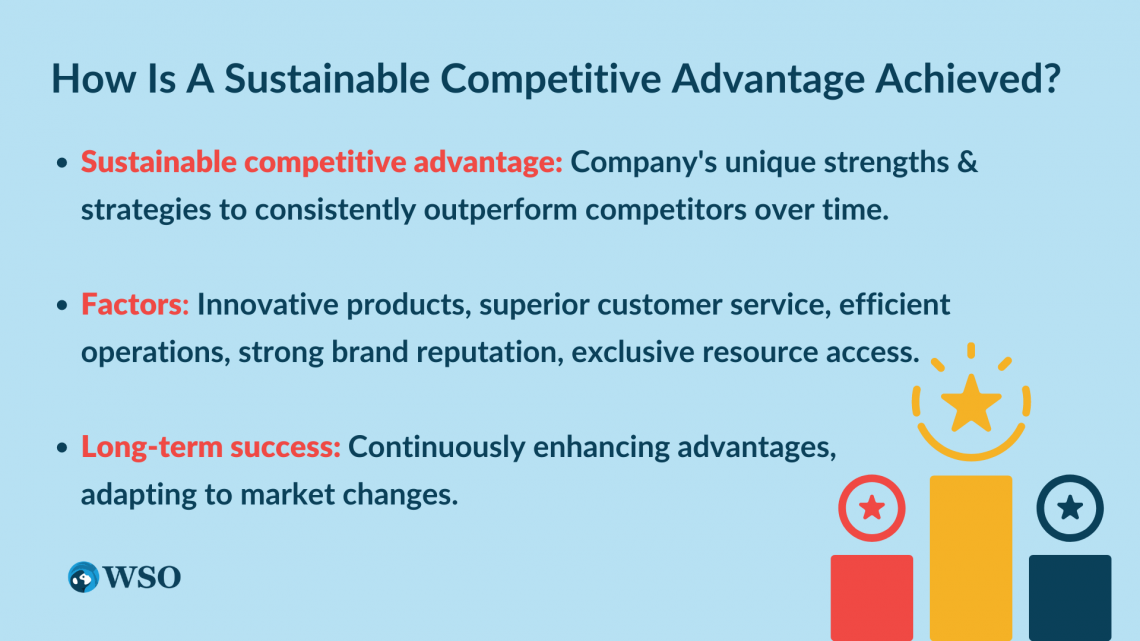
The first means a company can obtain a competitive edge is by developing and implementing a unique selling proposition, also known as a USP.
1. Unique Selling Proposition (USP)
A USP is a differentiating feature or a benefit that makes a firm stand out from its rivals. A USP is inimitable and cannot be replicated.
Also known as a distinguished proposition, it can help to reduce costs for a firm.
Due to the uniqueness of a USP, customers are likely to find value due to the distinguishability of the product or service compared to competitors.
Using a single USP retains customer attention and generates a strong image and identity.
A strong USP can position a company at the forefront of the market and characterize it as a customer-centric market leader.
This leads us to the next point.
2. Competitive Edge
A competitive edge can also be achieved by providing customers with a high-quality customer experience that other organizations cannot see. Customers are a vital part of business success.
As they play a crucial role in generating revenue, they can enhance business growth exponentially. Delivering sustainable competitive superiority can be determined by how a company values its ability to provide exceptional services.
A positive customer experience will increase top-of-the-mind customer awareness as their expectations would be exceeded instead of met.
By solving a customer's problems or creating a personalized experience for the customer, an upper hand can be achieved due to higher customer satisfaction.
A company showing integrity and spending time and effort to resolve customer issues generates a higher level of confidence in the business. This improved perception can lead to a stronger sense of loyalty and association with the brand.
When customer expectations and customer experiences are merged and equalized, economic value is maximized, increasing profitability and sales revenue for the organization.
What are the Benefits of Competitive Advantage?
The key benefits include:
- Company Growth
- Greater Market Share
- Stronger Customer Loyalty
1. Company Growth
Rapid innovation, robust technological infrastructure, accelerated digitalization, and following the latest developments in research and development are all contributing factors to gaining the attention of new customers and highlighting brand awareness.
All of these factors aid in building customer loyalty.
It combines individual competencies to create sustainable long-run growth.
2. Greater Market Share
The next advantage is an increase in market share. Differentiated products and services offered to end-users help create larger potential revenue, profitability, and sales.
The differentiation element of products and services creates a competitive edge and helps an organization dominate and overtake other key players within a market.
It highlights the core competencies, maximizing the utility of resources and emphasizing capabilities.
A company can achieve a more significant market share through a developed competitive edge and remain distinguishable and inimitable.
3. Stronger Customer Loyalty
Customer loyalty is a crucial benefit. This is because consumers benefit from a positive, unique, customer-centric user experience that puts innovation at the forefront of the business.
This encourages word-of-mouth promotion to other potential customers.
Lower relationship costs, increased sustainable profitability, and lower advertising costs are only some of the benefits of obtaining customer loyalty.
Loyal customers are price insensitive, have reduced cost serving, and demonstrate a challenge for rival strategies.
It helps an organization retain its customer base and hinders the growth of rivals by making it harder to enter and penetrate the market.
Repeated purchases convey a strong attachment by the customer to the supplier of the good or service. This bond is a crucial driver in a customer's decision to purchase.
Which Business Strategies Create a Competitive Advantage?
By providing a premium product due to differentiation elements, lowering costs, etc., competition can be reduced.
This requires developing an effective business strategy optimized to create the highest value. The key strategies, also known as Porter's Generic Strategies, are:
1. Cost Leadership
Cost leadership highlights business and operational efficiency through the production of large volumes of products that are standardized.
This allows a firm to achieve economies of scale and curve effects.
Cost leadership involves creating a product with lower costs accessible by a strong, large base of customers.
Costs must be minimized to achieve a leadership position within the market. Companies with cost leadership have a vast distribution network as their access to components, labor supply, and raw materials is favorable.
2. Differentiation Strategy
The following strategy is a differentiation strategy that focuses on the broader market of customers in the market segment where products and services are unique and irreplicable.
As a result of product differentiation, a premium price can be charged due to a product's unique features and characteristics.
The features may be associated with design, customer service, brand reputation, identity, or dealers. A differentiation strategy requires a USP to stand out against rivals and produce a competitive edge.
3. Focus Strategy
The last strategy is a focus strategy, where a company concentrates on a specific selection of target markets. All efforts by a firm are tailored to satisfy the wants and needs of the customers in a narrow market segment.
A focus strategy can be distinguished as either a cost-focus strategy or a differentiation-focus strategy. A cost-focus strategy optimizes production by driving costs as low as possible while still focusing on a small market segment.
On the other hand, a differentiation-focus firm uses differentiation in its small target market and aims for a unique value proposition.
Competitive Advantage in the Marketplace
The primary example is that of Starbucks. Starbucks Corporation is an American organization founded in 1971 and specializes in making coffee globally with overexpansion projects and a market presence in 62 countries.
A) Example #1
Starbucks produces high-quality coffee and roasted beverages where all coffee goods are trademarked and operations are licensed. This helps prevent other market competitors from imitating Starbucks coffee products.
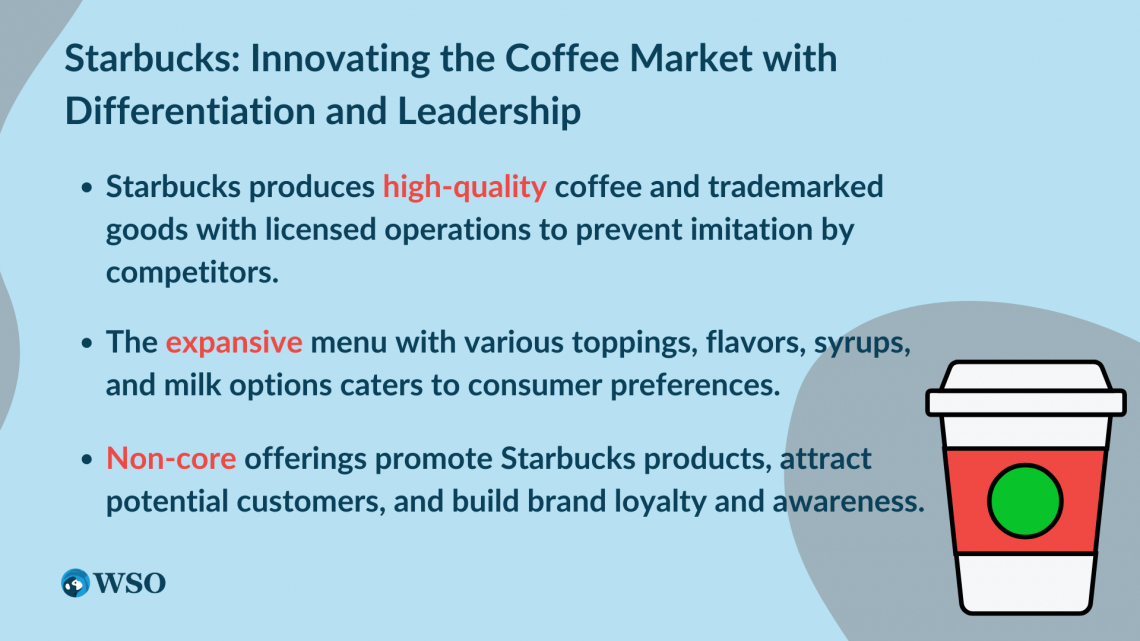
The CEO of Starbucks, Howard Schultz, announced that Starbucks grew using a leadership-focused strategy and innovation, contributing to its success. Innovation and differentiation by Starbucks are what made it a leader in the coffee market.
This was done by creating an expansive menu of toppings, flavors, syrups, and milk to give consumers a choice tailored to their wants.
The unique proposition of extensive personalization to match the exact requirements of the customer (87,000 potential drink combinations) contributed to customer satisfaction.
Starbucks also focuses on consumer health, where coffee products have an optional addition of protein, fruits, and vitamins to demonstrate care for its clients. This non-core offering contributes to promoting Starbucks products, attracts potential customers, and establishes brand loyalty and awareness.
Innovation, leadership, and differentiation are vital factors in Starbucks' position as a market leader in the coffee industry.
B) Example #2
Looking at another example, IKEA, founded in 1926 in Sweden, is a prime example of a successful organization in the global market that holds a competitive edge within the home furnishings industry.
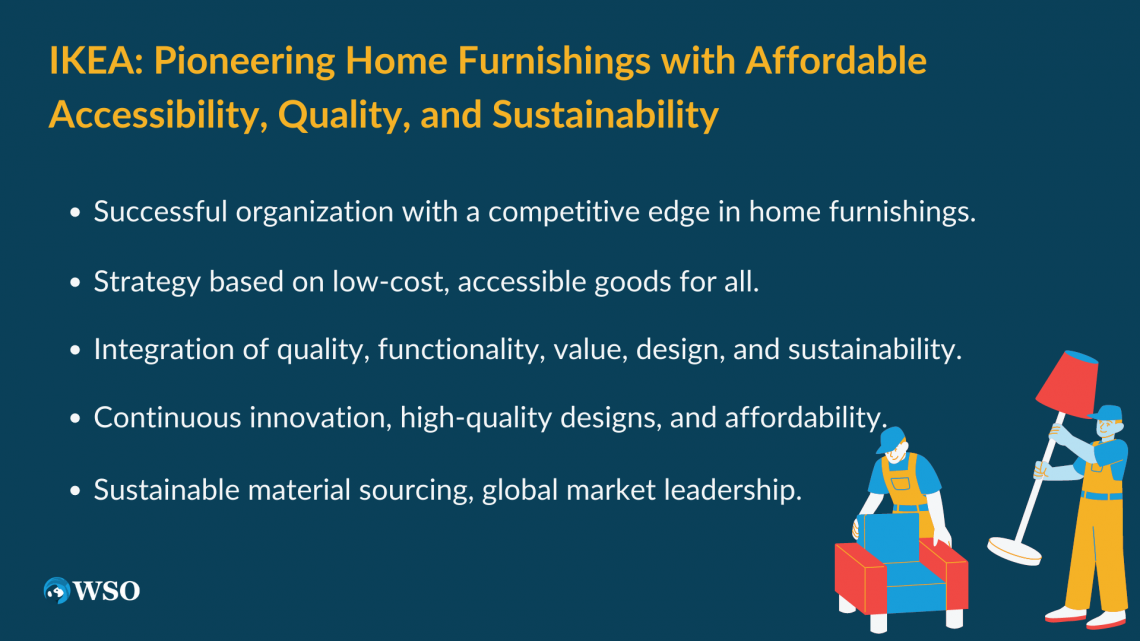
IKEA's corporate strategy is designed upon the IKEA concept. It aims to provide a range of home furnishing goods that are low cost and accessible to everyone.
IKEA integrates and combines quality, functionality, value, and design with elements of sustainability to demonstrate corporate social responsibility initiatives. This concept is evident in all stages of the IKEA business model.
IKEA's self-described democratic product design provides convenience and ease of daily living for customers without discrimination.
A driving source of growth is low prices based on a well-designed pricing strategy where quality is maintained despite reduced costs.
IKEA's cost efficiency strategy makes it profitable by using cost-cutting methods in its supply chain and production network. As a result, the high demand for its products creates a privilege of power for IKEA in the industry.
IKEA has a customer-centric focus, as IKEA provides exceptional customer experience and services, creating high levels of customer satisfaction.
IKEA continues to innovate and produce high-quality, unique designs and exceptional value home furnishing products at affordable prices. They also source all materials sustainably, making IKEA a global market leader powered by a solid competitive edge.
C) Example #3
The last example of a maximum competitive advantage is McDonald's. McDonald's dominates the international fast-food industry with diversified operations in over one hundred countries.
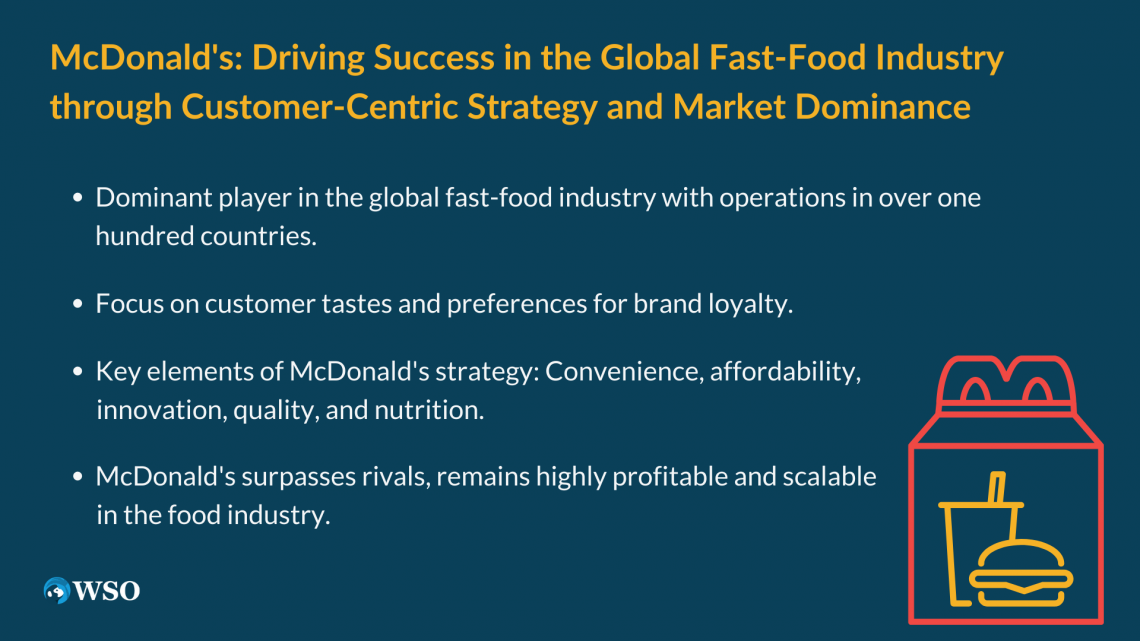
Founded in 1947, McDonald's was a franchise that grew into a successful corporation in the food industry. It focuses on the tastes and preferences of customers to fulfill their wants and compete for brand loyalty.
The central components of McDonald's' strategy to maintain a sustainable competitive advantage are convenience, affordability, innovation, quality, and nutrition, in addition to value-added services.
This strategy has enhanced customer perception of the McDonald's brand and allowed the company to become a market leader.
By capitalizing on its core competencies and diverse resources, McDonald's has become a successful business that has overtaken rivals and remained a highly profitable and scalable organization in the food industry.
Conclusion
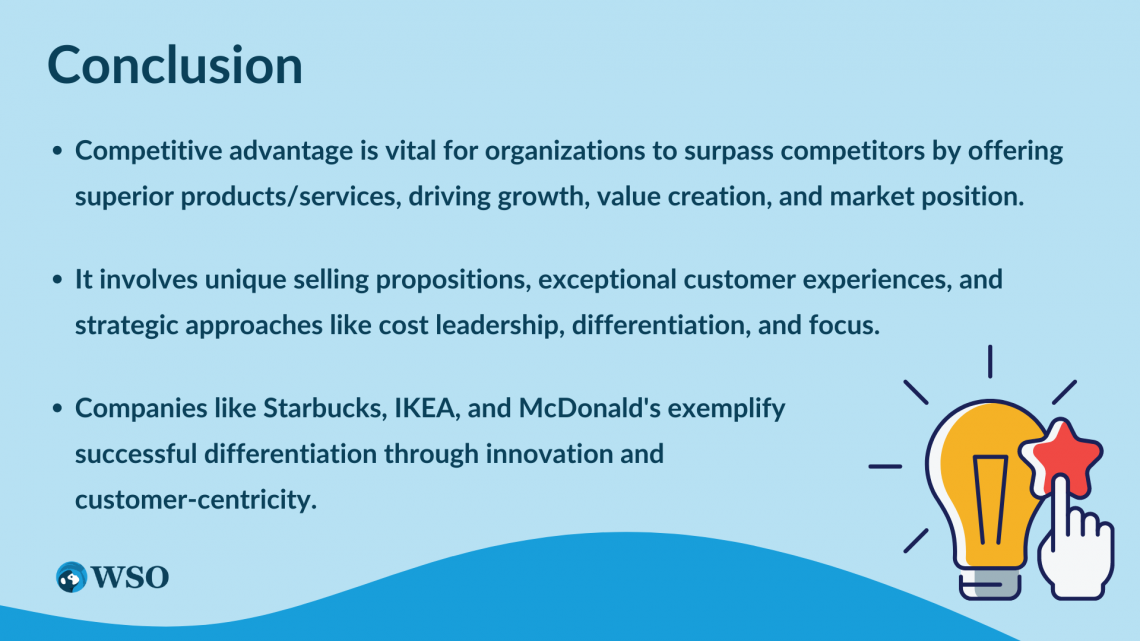
A competitive advantage is essential for sustainable business growth. It is crucial to ensure profitability, high returns on investment, and sales revenue, as seen in Starbucks, IKEA, and McDonald's examples.
Without one, market rivals can easily replicate products and services and lead to business failure.
Every organization must strive to develop and differentiate itself within its market space. A well-planned, tactical, and innovative business strategy is the answer to a sustainable competitive advantage that will help a business succeed.




or Want to Sign up with your social account?